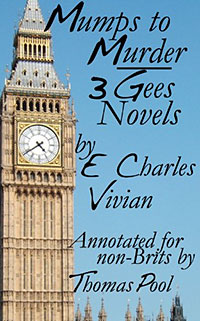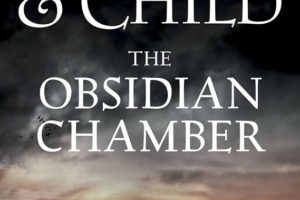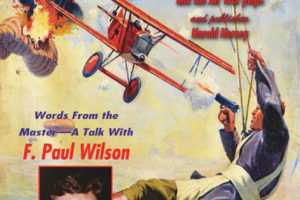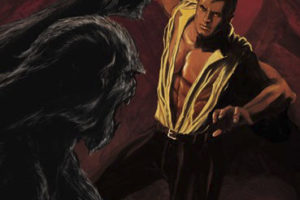 I recently posted on a new (to me) occult detective I discovered: Gees, real name Gregory George Gordon Green. Created by British author and editor Charles Henry Cannell (1882-1947), better known by one of his pseudonyms E. Charles Vivian, but these appeared under his Jack Mann pseudonym.
I recently posted on a new (to me) occult detective I discovered: Gees, real name Gregory George Gordon Green. Created by British author and editor Charles Henry Cannell (1882-1947), better known by one of his pseudonyms E. Charles Vivian, but these appeared under his Jack Mann pseudonym.
There are eight novels in the series, and I read the first and third. Recently I got the second, fourth, and fifth: Grey Shapes, The Kleinart Case, and Maker of Shadows. All originally appeared, so I am told, in 1938. All eight are available from Ramble House in both paperback and hardcover.
We are introduced to Gees in Gees’ First Case. We learn his background: a former policeman who has quite to form his own detective agency, to the disapproval of his father, a general. His agency is just him and a secretary, Eve Madeleine Brandon. But there is no hanky panky there. Gees investigates anything from “mumps to murder,” as his card says, and thanks to the funds he took from communist conspirators in the first story, he is free to take the cases that interest him.
The first story had nothing supernatural about it, but with the second one, Gees will be facing real abnormal matters. In Grey Shapes, Gees is asked to investigate a case of dogs killing sheep up in the Cumberland. The police can not figure out what is doing the killing. And the owner is starting to think there may be a supernatural cause. Gees is on the case, and soon learns the cause: werewolves.
These are no movie werewolves. They don’t change at the full moon, but transform when they want to at night, and have control of themselves to a degree (i.e., they are not just mindless killers when in wolf form). But have some of their wolf characteristics when human. But they aren’t humans, but more fairy folk, and could be hundreds if not thousands of years old. And silver isn’t needed to kill them.
Gees puts an end to them. Then heads home. But he does meet a girl he talks a fancy to. Does anything come of this in future works? I somehow doubt it.
Next up is The Kleinart Case. This time, a German has hired Gees to protect him from “nothing.” He is working on a method of bring out new colors in chalk that could be worth a lot, and he worries it will be stolen, so hires Gees to protect him. It turns out that the “nothing” is an occasional “haunting” at night, but unlike Nightmare Farm, what really puts an end to it is Gees investigating on his own what is going on. Gees figures out that what was thought to be an accidental death is actually murder by his client. So he basically works it all out without him knowing and turns it all over the the police in a neat bundle. The subsequent trial just brings more fame to Gees. While the supernatural elements here are very minimal, it is a good mystery.
There are some interesting scenes between Gees and his father, including one where he visits Gees at his office and meets his secretary, and learns that she is the daughter of one of his best friends. And as always there is a girl Gees is interested in, but nothing comes of it.
In what is probably the most explicate occult case is Maker of Shadows, where Gees goes up against a evil wizard Gamel MacMorn, a survivor of the “Azilian” race. Gees is called in to help Margaret Aylener, last of a Scottish family who has been fighting MacMorn off for generations. MacMorn has the ability to regenerate every so often, so he basically comes back as his “son,” and he desires Helen. Who will be the only one to continue the Aylener family line.
The Azilian race is one that Cannell made up (he used the name of a real paleolithic culture), and they (or their descendants) will apparently appear in further works. They are an ancient pre-medieval people who worship a demon goddess called The Unnamed. There are connections with them and the Sidhe (the fairy folk that appeared in Gray Shapes). We get some “history” of early man in Great Britain that is not too accurate. The Cro-Magnons were not a separate race, nor were they wiped out.
Gees looks into the case, decides not to take it. But finds that MacMorn has targeted him not knowing this. When Helen disappears, he works to confront MacMorn and free her. Does he succeed? You’ll have to read it and find out.
This story was reprinted (in an edited/expurgated version I am told) in Argosy, with illustrations by Virgil Finlay, which are included in Ramble House’s edition. This is a real bonus. Two others in the series appeared in the pulps, so I wonder if the illustrations were also included.
Frankly, I could see Gray Shapes and Maker of Shadows made into good movies by a British studio back in the ’40s or ’50s. Atmospheric, with interesting English history and the like. Wouldn’t work today, audiences would want a lot of gore (not much here) and some sex (none here).
As I noted in my original posting, Gees is of the type of occult detective who is an ordinary man, with ordinary skills and knowledge, who happens to find himself confronting the supernatural. That’s unlike other occult detectives who have already have skill and knowledge of the occult, and in some cases seek it out. But it does appear the Gees learns from each of his cases to help him in the future.
It was also interesting seeing the connections between the books. In Grey Shapes we hear about the case from the previous book, in the Kleinert Case, mention is made of Nightmare Farm.
I look forward to reading the final three books.




Excellent. I read a couple of Gees novels years ago in pulps; now I learn that they were probably abridged, based on what you say above. I am going to track down and read all these books.